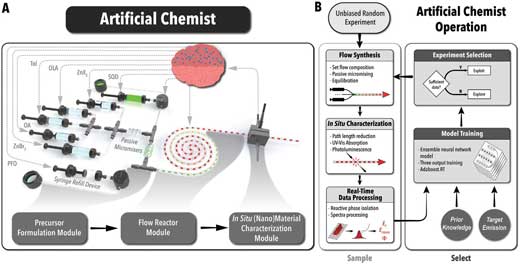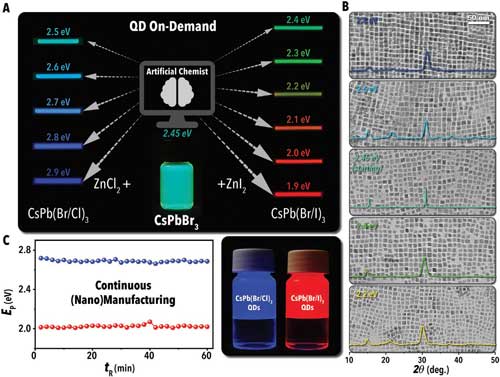| Aug 03, 2020 | |
An autonomous synthesis bot for quantum dots(Nanowerk News) While in their infancy, self-optimizing devices have begun to unravel the challenges of these more complex chemical processes, with their existing applications spanning organic reactions to nanocrystal syntheses. | |
| Recent advances in supervised and reinforcement machine learning techniques, such as multi-output neural networks, ensemble methods, and Bayesian optimization, provide an exciting opportunity for reshaping the synthesis and optimization of quantum dots (QDs) through the machine-learning-based direction of a high-throughput QD synthesizer. | |
| Quantum dots are nanometer-size, semiconducting materials whose tiny size gives them unique optical properties. Much effort has been put in building quantum dots from perovskites, which already show much promise for solar panels, LEDs and laser technologies. | |
| Despite the substantial improvement in performance of perovskite QDs over the past few years, one major obstacle hindering their development is trial and error-based QD synthesis, discovery, and optimization methods. | |
| To overcome these obstacles, researchers have developed an intelligent flow-based QD synthesis strategy – i.e., the Artificial Chemist – which utilizes plug-and-play fluidic microreactors capable of autonomous synthesis and optimization of colloidal QDs across multiple target parameters simultaneously. The team reported their findings in Advanced Materials ("Artificial Chemist: An Autonomous Quantum Dot Synthesis Bot"). | |
 |
|
| Design and operation of the Artificial Chemist. A) Schematic of the developed smart modular fluidic microprocessor for autonomous synthetic path discovery and optimization of colloidal QDs and B) the process flow diagram detailing its operation. (Reprinted with permission by Wiley-VCH Verlag) (click on image to enlarge) | |
|
The Artificial Chemist, shown in the figure above, can rapidly and efficiently:
| |
| As the authors explain, automated experimentation strategies often reduce the cost and time required to study and synthesize materials, but the dependency on user-driven experiment selection undoubtedly limits their exploration and optimization efficiency. | |
| "A fully closed-loop autonomous experiment selection and execution platform (i.e., the Artificial Chemist), would therefore, significantly expedite the tedious process of colloidal synthetic path discovery and reaction optimization, at a fraction of the cost and material consumption of the current paradigm," they point out. | |
| The self-driving Artificial Chemist is comprised of a precursor formulation module (seven syringe pumps, two syringe refill systems, and two inline passive micromixers), a flow reactor module, and an in situ QD characterization module (a custom-developed flow cell for simultaneous in situ UV???Vis absorption and photoluminescence spectrum monitoring). | |
| Flow is segmented into reactive solution and perfluorinated oil (PFO) phases. The PFO carrier phase enhances mass transfer in the reactive phase and minimizes fouling by separating the reactive solution from the tubing wall. The operation sequence of each colloidal synthesis reaction, including reagent refill, spectral sampling, and real-time processing are fully automated using a central computer controller. | |
 |
|
| QD synthesis on-demand enabled by the Artificial Chemist. A) Illustration of the UV-illuminated starting perovskite QDs and final halideexchanged synthesized in flow for all 11 target emission colors. B) Transmission electron microscopy (TEM) images with X-ray diffraction (XRD) spectra overlay of the purified halide-exchanged QDs obtained from (descending order) ZnCl2 exchange reactions with target emissions of 2.8 and 2.6 eV, the starting QDs, and ZnI2 reactions with target emissions of 2.4 and 2.2 eV. C) EP values continuously measured for a 1 hour continuous collection of 2.7 eV (blue) and 2.0 eV (red) perovskite QDs with the corresponding UV illuminated products in 20 mL vials. (Reprinted with permission by Wiley-VCH Verlag) (click on image to enlarge) | |
| The Artificial Chemist, in addition to accelerated synthetic path discovery and optimization of colloidal QDs, can also rapidly synthesize a library of high-quality QDs on-demand, as shown in the figure above, utilizing the neural network optimization algorithm with pre-training based on in-house generated QD synthesis data. | |
| The wuthors point out that the developed plug-and-play autonomous flow synthesis strategy may be quickly adapted to other reaction systems beyond colloidal QDs such as metal, metal oxide, and carbon-based nanoparticles. | |
| "'This approach can also be expanded to include downstream dispensing of colloidal suspensions and solutions directly into coating and printing platforms for the fabrication of optoelectronic devices," they conclude. "An additional implication of the Artificial Chemist is intensified, green, and more consistent manufacturing of advanced nanomaterials as compared to flask-based studies, which are limited by batch-to-batch precursor variations and inefficient/irreproducible heat and mass transfer rates." | |
| Overall, the autonomous robotic experimentation strategy embodied by the Artificial Chemist offers broad-reaching applications in rapidly advancing the synthesis of colloidal semiconductor nanocrystals and any other solution-processed nanomaterial. |
 By
Michael
Berger
– Michael is author of three books by the Royal Society of Chemistry:
Nano-Society: Pushing the Boundaries of Technology,
Nanotechnology: The Future is Tiny, and
Nanoengineering: The Skills and Tools Making Technology Invisible
Copyright ©
Nanowerk LLC
By
Michael
Berger
– Michael is author of three books by the Royal Society of Chemistry:
Nano-Society: Pushing the Boundaries of Technology,
Nanotechnology: The Future is Tiny, and
Nanoengineering: The Skills and Tools Making Technology Invisible
Copyright ©
Nanowerk LLC
|
|
|
Subscribe to a free copy of one of our daily Nanowerk Newsletter Email Digests with a compilation of all of the day's news. |
